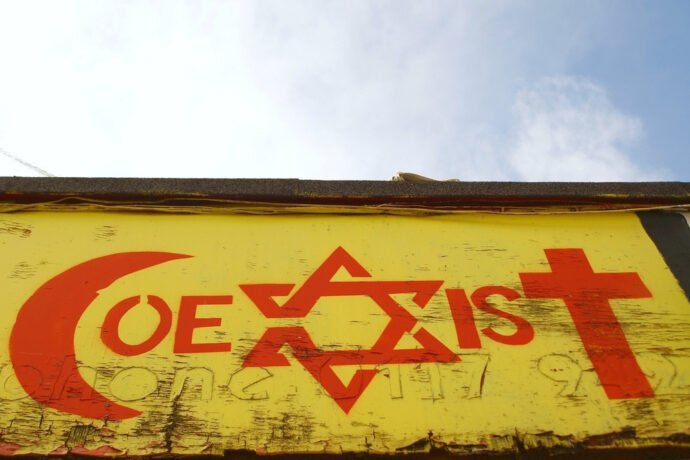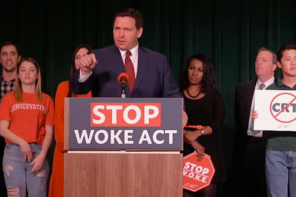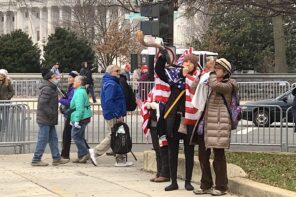Eboo Patel’s new book, Interfaith Leadership: A Primer, came out in July, which was at least four months too early. In the heat of a bitter national election, a book calling for toned-down domestic diplomacy seemed out-of-sync with the political mood. Why talk with other people when you can vote them into submission?
Now, after an election that has left many Americans feeling baffled, infuriated, and terrified by the beliefs of their fellow citizens, Patel’s message seems a little more apt. As a longtime interfaith organizer, Patel specializes in generating peaceful conversations in tense spaces. Meanwhile, one consistent theme of the left-wing election post-mortem has been that Americans—and especially white Americans, of all political stripes—need better methods with which to listen to their fellow citizens.
Can the interfaith movement play a role there? Certainly, Patel’s primer is a savvy guide to pluralistic listening. But the book also illustrates some of the shortcomings that the interfaith movement brings to any larger pursuit for a more pluralistic society.
There may not be a unified Interfaith Movement, but Patel has been anointed as the figurehead of something. Born in India and raised a Muslim in Illinois, Patel experienced racist and Islamophobic bullying as a child. In 2002, he founded Interfaith Youth Core, a nonprofit that supports interfaith organizing on college campuses. Today, he runs the IFYC, writes books and articles, and speaks on campuses. He also served on Barack Obama’s faith council.
Interfaith Leadership is a business-school-style leadership manual grafted onto a Pluralism 101 course. It includes autobiographical details from Patel’s life and sociological quick-hits about the challenges of a diverse society.
Ultimately, Patel imagines a cadre of interfaith leaders who organize pluralistic groups around common themes, such as social action. He argues that these leaders will unite people and make for a more peaceful society.
At its best, the book functions as a field guide to democratic compassion. Again and again, Patel pushes would-be leaders to respect other people’s differences, even as they try to get inside their heads. One of the book’s central sections is a case-study about an imaginary small town that welcomes a Muslim family. Rather than tell the story from the detached position of an analyst, Patel pivots from person to person, trying to understand the uncertainties and stressors that every player faces.
Later, in a wonderful aside, Patel describes reading the New York Times each morning and trying to imagine how people he knows might read those same articles. What implications would this piece of news have in this religious community?
These are compassionate exercises for concerned citizens. But I do not think that they make a serious prescription for pluralism.
Much of Patel’s small-town case study takes place in a high school, and, as I read Interfaith Leadership, I found myself wondering how my 12th grade self would have digested Patel’s larger message. I grew up in east Tennessee, one of perhaps a dozen Jews in a school of more than a thousand kids. My sister and I were the most visibly Jewish kids there. Interfaith work was part of our lives, whether we liked it or not.
To be honest, by the end of high school, formal interfaith interaction was the last thing that I wanted. The tokenizing had become more exhausting than the occasional anti-Semitism. What I yearned for was not so much an environment free of interfaith tension as an environment where people’s identities were allowed to be more multiple. The fact that interfaith work purposely foregrounds that difference, rather than letting it unspool as part of a larger interplay of worldviews, would have struck me as faintly bizarre.
Back then, conscious interfaith work seemed like an act of desperation—for people who simply could never escape being pigeonholed by their faith—or an act of indulgence—for people so accustomed to welcoming spaces that they could take the occasional vacation into tenser territory, especially when a warm-and-fuzzy outcome seemed all but assured.
There’s a tension here that Patel alludes to but doesn’t explore. The short version is that Patel’s book is not very intersectional. More specifically, there’s something a little artificial about all this interfaith-iness, in that it pulls one element of identity—religious affiliation—to the fore, reads it as a core fulcrum of tension, and then builds an entire process of negotiation and diplomacy around that one identity point.
This seems like a narrow way to think about identity. It’s also a narrow way to think about pluralism, which involves the interaction of all kinds of worldviews, not just those that fit into the box we call faith—itself a very Christian concept.
As Patel argues, interfaith work can be a route to conversations about other kinds of diversity. Still, Patel made his career, in part, by insisting that faith is uniquely divisive in American society. Here he is in the introduction to his 2007 book, Acts of Faith:
One hundred years ago, the great African American scholar W. E. B. Du Bois famously said, “The problem of the twentieth century is the problem of the color line.” I believe that the twenty-first century will be shaped by the question of the faith line. On one side of the faith line are the religious totalitarians….On the other side of the faith line are the religious pluralists, who hold that people believing in different creeds and belonging to different communities need to learn to live together.
To restate: Patel was suggesting that religious divisions are now a bigger question for the United States than race. This was wrong in 2007. It is wrong today. Not only does it understate the challenge of the color line. It also overstates the role of faith.
Yes, religious ideas are involved in conflict. But they rarely appear alone. The two most virulent forms of religious prejudice in America today—Islamophobia and anti-Semitism—are largely about xenophobia and the construction of Islam and Judaism as racial categories. As I have argued elsewhere, political positions are more divisive than religious positions for many Americans. Even religion-linked strife seems driven as much by politics, power, and historical grievances as by abstract questions of doctrine.
A lot of campus interfaith work seems to place too much emphasis on faith as a wedge. Often, its premise seems to be that people of the same age, class, education, nationality, and political orientation have serious cause to dislike each other. When instead they get along, that harmony is fodder for a distinctive kind of civic schmaltz—the earnest celebration of something that was never especially surprising to begin with.
In the first page of Interfaith Leadership, Patel writes that “my own position as a Chicago-based, broadly progressive, Oxford-educated Ismaili Muslim who leads a nonprofit organization puts me in circles where I am far more likely to be in relationship with highly educated, city-dwelling, liberal Jews than with evangelical pastors leading house-churches in western Oklahoma.”
But why should Patel and those highly educated, liberal Jews want to fight in the first place?
A little sentimentality is fine. But the schmaltz-iness obscures questions that Interfaith Leadership seems poorly equipped to answer. How well does interfaith organizing work when there are serious political, racial, or class tensions at play, alongside those differences in faith? And when is it no longer acceptable to suppress those differences for the sake of fellowship?
Patel argues that people sometimes need to just ignore tensions and put up with ideas that seem hateful. In a way that will seem alien to some partisans, he embraces the experience of “looking around a room and knowing how deeply I disagree with many of the people gathered on many things.” His ideal of an interfaith space is a place where it’s possible to build relationships with those people—to “feel an electric current of recognition.” Patel continues:
Such a feeling is necessarily partial and contingent. In other situations, we may well find ourselves on opposite sides of the picket line. But I will know that those disagreements are also partial and contingent, that our widely held and deeply shared values are just as real as our arguments.
There is an elusive, squishy line between constructive conciliation and passivity in the face of injustice. For those who are suffering, not all disagreements feel so “partial and contingent.” Were Patel talking about racism or sexual violence, this call to diplomatic detachment would not be made so lightly. And the thing is, I think Patel is talking about racism and sexual violence, and much else, when he talks about religious strife. The threads are not so separable.
But having isolated religious identity into a safe little box, Patel seems unwilling, in his primer for interfaith leaders, to explore the limits of that diplomacy.
That’s a shame. It’s hard to find strong, progressive defenses of diplomacy, and I wish that Patel’s primer for interfaith leaders had been more ambitious. There seems to be a real need for thinkers who take seriously these concerns about entangled identities and passivity in the face of injustice, but still make the case (and set the ground rules) for radical diplomatic inclusion. For all his thoughtfulness as a writer, Patel doesn’t give us that vision here. But I hope he’ll be part of the conversation.






